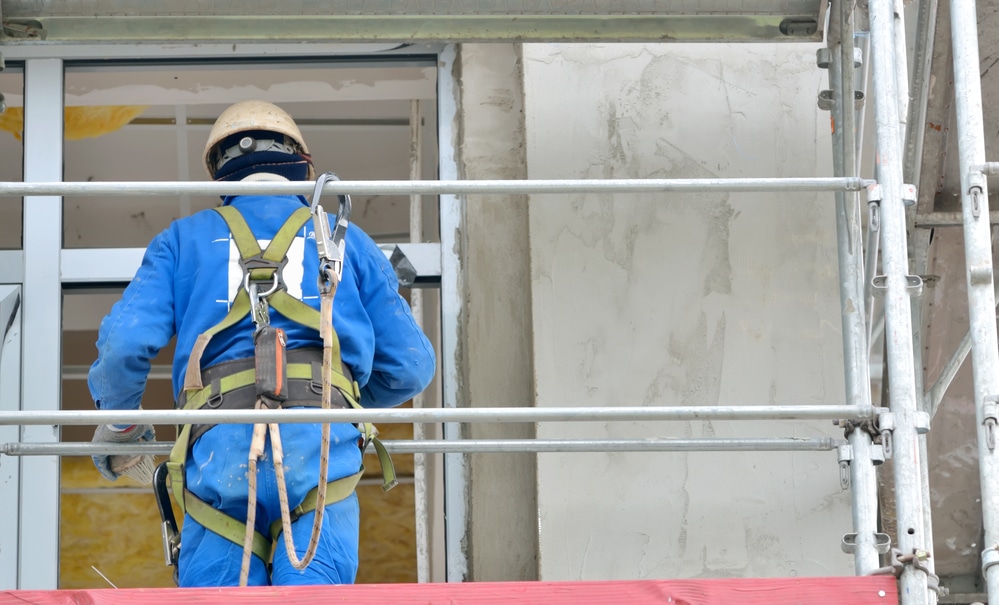Understanding the Load Capacity of Scaffolding

The Occupational Safety and Health Association (OSHA) sets numerous federal standards to protect workers across many industries against workplace hazards.
Scaffolding is notoriously dangerous, exposing your employees to risks such as falls from heights, falling objects, and contact with power lines. Our write-up explains how to design scaffolding with load capacity in mind.
We have created a video-based course to help train your workers if you need employee scaffolding safety training.
Safety Measures Applicable to Scaffolding
Scaffolding in industries such as construction continues to rank high as a source of workplace injuries and fatalities. As a result, OSHA stipulates multiple measures to reduce the dangers posed by scaffolds in OSHA Regulation 3150 of 2002 (as revised).
The following components and aspects of scaffolding are subject to safety requirements to increase workplace safety:
- Fall protection or personal fall arrest systems
- Guardrail height
- Cross-bracing
- Mid-rails
- Footing
- Platforms
- Guying ties and braces
- Training
- Inspections
- Erecting and dismantling
- Load-bearing capacity

Scaffold Load Capacity and the Risk of Collapse
A common risk when dealing with scaffolding is that it may collapse under the weight of your workers, tools, and materials (the live load) or even the weight of the scaffold components (the dead load).
What Is the 4 to 1 Rule in Scaffolding?
As a result, OSHA standard 3150 states in sections 1926.451(a)(1) and (3) that the scaffold weight capacity shall be such that the entire scaffold, and every component thereof, shall be able to bear not only its own weight but also at least four times the maximum intended load applied to it.
In the case of suspended scaffolding, where the platform hangs from overhead rigging, this rigging must have a weight capacity of at least six times the maximum intended load for the scaffold in question.

Why the Required Load Capacity of Scaffolding Systems Is So High
Each component of scaffolding systems and the entire scaffold structure must support at least four times the maximum intended load transmitted to that particular scaffold part.
This seemingly excessive requirement acts as a safety factor, ensuring that the maximum weight placed on the scaffold does not exceed the rated load capacity of the structure.
Adding more weight will not generally result in the scaffold failing. However, because site conditions such as weather result in more stress on the scaffold, it is imperative to adhere to OSHA regulations.
The Meaning of the Maximum Intended Load Applied
OSHA is specific about the maximum intended load capacity of scaffolding: it includes the combined weight of all workers, their hand tools and equipment, and all materials being used at any given time. Together, these constitute the live load placed on the scaffold.
All persons working on a scaffold are considered to weigh 250 pounds each.
The weight of the scaffolding itself is known as the dead load and includes the weight of the platform, guardrails, frames, and cross braces.
Additionally, any other loads that can reasonably be expected to affect the scaffolding must be considered. High winds, for example, constitute an additional load.
The terrain of the job site also plays a role: the ground at a construction site is typically uneven, transmitting shear forces to the scaffolding components.
Transmitted loads vary from one part of the structure to another. In general, the scaffolding load capacity of a component near the base of the scaffolding must be greater than that for higher pieces.

How Much Weight Scaffold Components Must Be Able to Bear
Employers may be concerned about how strong the scaffolding structures must be; after all, the total weight capacity of all these scaffolding systems will be enormous.
However, the regulations state that each scaffold component must be capable of taking four times the load that will be transmitted to it. Only some of the parts of a scaffold will take the weight of the entire structure.
It will take someone with considerable technical knowledge and experience or even a qualified engineer to calculate the precise load transmitted to each scaffold component. However, applying the safety factor is straightforward once these forces are known.
The Rated Load Capacity of Scaffolding
Scaffold load capacity differs depending on its maximum load capacity. Depending on how much weight the span area of the platform can bear as a safe working load, scaffolding falls into light-duty, medium-duty, or heavy-duty categories.

The Definition of a Light-Duty Scaffold
A light-duty scaffold has a rated capacity of at least 25 pounds per square foot, spread evenly across the entire platform. A scaffold can also be considered light-duty if it can support a minimum of 250 pounds concentrated in the center of the span.
Light-duty scaffolds are designed to support workers and tools only, making them appropriate for applications such as repair jobs. They are also known as standard scaffolds.
The Requirements of a Medium-Duty Scaffold
Medium-duty scaffolding is required to handle a load capacity of at least 50 pounds per square foot, also spread across the whole platform.
Medium-duty scaffolds are designed for an intended load that includes workers and tools and can support construction materials such as bricks and mortar, making them suitable for brick masons to lay courses at height and similar construction work.
The Criteria for a Heavy-Duty Scaffold
Heavy-duty scaffolding can support at least 75 pounds per square foot across the entire square footage of the platform.
Heavy-duty scaffolds are designed with a high maximum intended load capacity in mind, being suitable for jobs where stored materials and workers, tools, and materials must be placed on the scaffold ahead of their installation. They are sometimes known as “stone setters” scaffolds.
How to Determine Whether a Scaffold Meets the Required Load Capacity
The deflection method is the most commonly used means of determining whether a scaffold falls within the rated load capacity or is overloaded.
Whether the platform consists of planks or decking, it must not deflect more than one-sixtieth of the span when under the load capacity for the scaffold’s intended use. A designated competent person is responsible for determining this deflection with a straight edge and a tape measure.
To calculate the maximum deflection permissible, divide the total span of the platform in inches by 60. A 60-inch span may have, at most, one inch of deflection.

What Is the Formula for the Load Capacity of Scaffolding?
Scaffold load capacity is the maximum load a particular scaffold can safely support. It is calculated by the manufacturer and indicated on the scaffolding.
The manufacturer uses the following load calculation: the load capacity is the scaffold weight capacity divided by the sum of the scaffold’s weight and the maximum intended load.
How to Calculate Scaffold Weight Capacity
The scaffold weight capacity can be derived from the base rating of a particular scaffold system: 25, 50, or 75, corresponding to the three categories of scaffolding described above.
Multiplying this figure by the square footage of the work surface gives a result that is the scaffold weight capacity. For example, a medium-duty scaffold with a square footage of 30 square feet will have a scaffold weight capacity of 1500 (50 times 30).
The scaffold weight capacity should not be exceeded, nor should the maximum intended load; where a discrepancy exists between these figures, always defer to the lower one.
What Is the Maximum Load for a Heavy Duty Scaffold?
With a well-designed scaffold, the maximum load can be as high as 10,000 pounds, transmitted evenly through each foot. In other words, each of the legs and feet of such a scaffold has a maximum load capacity of 2,500 pounds.
When a Competent Person Is Required
OSHA requires a competent person to be involved with inspecting a scaffold to maintain its safety. This individual must be able to implement any measures required to eliminate dangers and prevent accidents or injuries.
When a Qualified Person Is Required
A qualified person has appropriate qualifications or extensive experience that gives them the expertise to train employees, design scaffolding and equipment, design rigging or adjustable suspension, and design scaffolding components.
When an Engineer Is Required
Only an engineer may sometimes design scaffolding, equipment, or a particular scaffold component. These include multi-point adjustable suspension scaffolds, scaffolding that will be mobile while occupied by personnel, scaffolding supporting a cantilevered load, and all very tall scaffolding.
An engineer must also design scaffold equipment such as outriggers and parts thereof.
Summary: What Is the Load Capacity for Scaffolding (OSHA)?
OSHA defines scaffold load capacity in terms of the 4 to 1 rule. This rule states that the safe working load for any scaffolding system is one-fourth of what the scaffolding equipment can handle.
Or, as previously stated, the scaffold and each component can support four times as much weight as the maximum intended load that will be transmitted to it. This load must account for the total weight of the scaffold, workers, their tools and equipment, and building materials.
This 4 to 1 rule provides a safety factor for additional strain on the scaffold, such as high winds or uneven terrain. It also allows for any human error in calculating the load transmitted to a component, without which that part could fail.